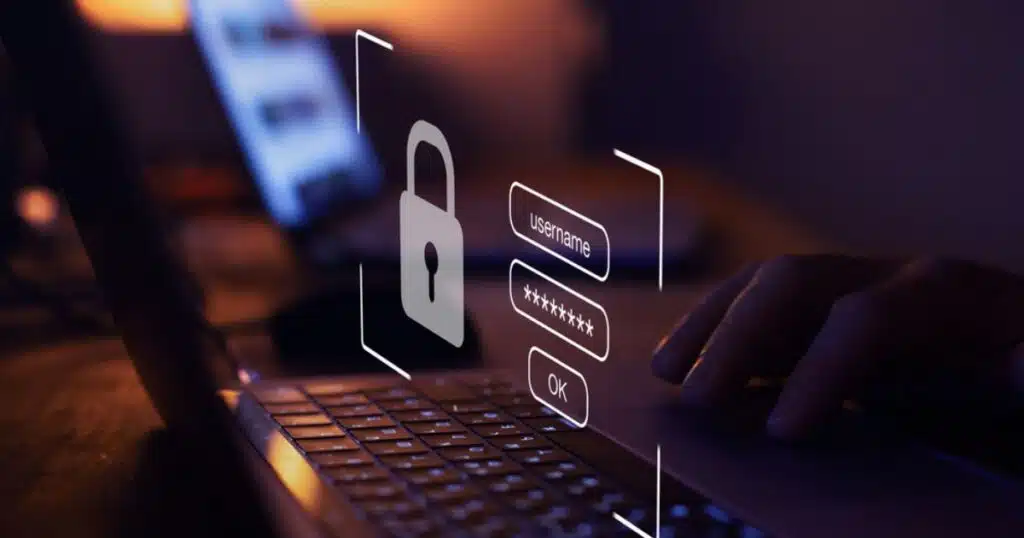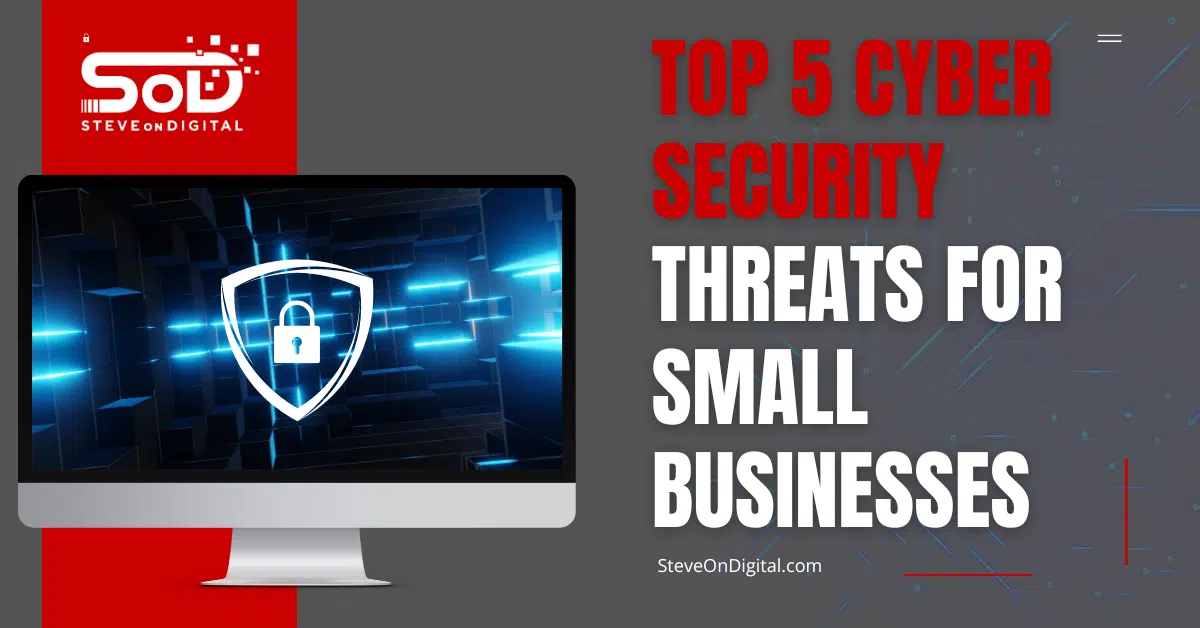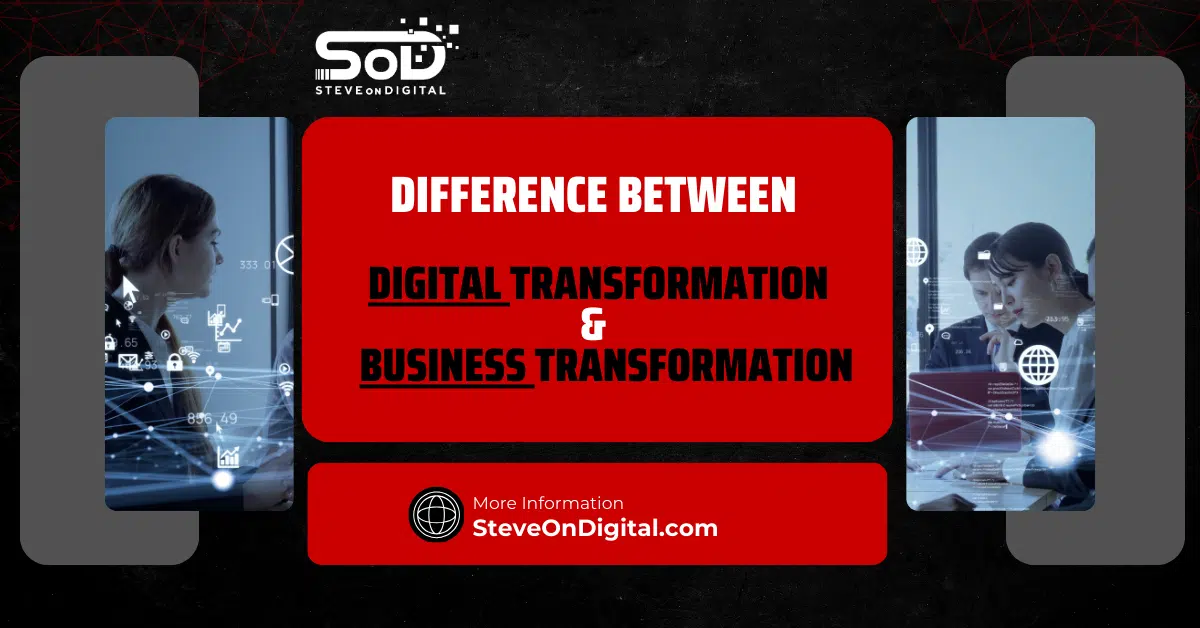Hello there, I’m Steve Johnston, and I run SteveOnDigital.
Today, we’re diving into a topic that’s close to my heart and crucial for the livelihood of small businesses: cyber security.
As someone who’s navigated the choppy waters of digital threats firsthand, I’ve seen the impact that cyber incidents can have on businesses just like mine and perhaps yours.
Why Is Cyber Security Essential?
For us, the owners of small businesses, cyber security isn’t just a buzzword—it’s a crucial shield.
It protects everything from our customer data to our business reputation. Small businesses are increasingly targeted by cyber criminals.
Unlike large enterprises, we often lack the vast resources necessary to rebound quickly from a cyber attack.
Defining The Basics
- Cyber Security: This is the practice of protecting systems, networks, and programs from digital attacks. These attacks usually aim to access, change, or destroy sensitive information, extort money from users, or interrupt normal business processes.
- Small Businesses: Typically defined as enterprises with fewer employees and lower revenue than larger companies, these entities often operate with limited IT resources, which can make them attractive targets for cyber attacks.
- Cyber Threats: These are potential dangers that could exploit vulnerabilities in our systems to steal data, cause damage, or disrupt operations.
Why Cyber Security Matters For Small Businesses
Impact On Operational Integrity And Reputation
In my experience, a single cyber breach can not only disrupt operations but also severely damage a business’s reputation.
We’re in an era where customers expect their data to be handled with the highest level of security.
A breach can lead to a loss of trust that’s hard to rebuild.
For example, after a minor incident where suspicious activity was detected on our network, we had to work double-time to reassure our clients that their information remained safe.
This was a wake-up call to strengthen our defenses, an investment that has paid dividends in customer trust and business resilience.
Protecting Critical And Sensitive Data
For small businesses like ours, the data we hold—be it customer details, financial information, or proprietary business knowledge—is critical.
This data is not just sensitive; it’s the lifeblood of our business strategy and operations.
Protecting this data is not merely a technical requirement but a core business strategy.
The Growing Threat Landscape For Small Businesses
In the digital age, the threat landscape for small businesses like mine—and possibly yours—is not just growing; it’s evolving rapidly.
Running SteveOnDigital has taught me that staying ahead of cyber threats isn’t just about keeping the lights on; it’s about protecting our future.
Cyber Threats Are On The Rise
It’s alarming but true: small businesses are increasingly targeted by cyber criminals.
According to a recent report, small businesses make up 43% of cyber attack victims, and these incidents are on the rise.
Why? Because we often lack the cybersecurity infrastructure of larger enterprises, making us softer targets.
Real-World Impact
Let me share a quick story.
A fellow small business owner I know suffered a major ransomware attack last year.
Hackers locked him out of his own systems and demanded a ransom that nearly crippled his business financially.
It was a harsh reminder of how real and immediate these threats are.
Evolving Methods
Cyber criminals are not just sticking to old tricks; they’re innovating.
Phishing scams, for instance, have evolved from poorly written emails to sophisticated schemes like Business Email Compromise (BEC), targeting companies just like ours to steal sensitive information or funds.
The Importance Of Proactive Security Measures
In combating cyber threats, the difference between a proactive and reactive approach can be the difference between a secure business and a disastrous breach.
Proactive Vs. Reactive
A reactive strategy often means scrambling after an attack has already occurred.
On the other hand, a proactive approach involves preparing and strengthening your defenses before an attack happens.
From my experience, the latter not only saves money in the long run but also spares you the headache of dealing with the aftermath of a security breach.
Implementing Early Security Measures
Investing in robust security measures early on is crucial.
For instance, implementing multi-factor authentication across all user accounts in your organization can significantly reduce the risk of unauthorized access.
At SteveOnDigital, we adopted multi-factor authentication early, which has thwarted several attempted breaches.
Let’s talk about antivirus software and patch management—two critical components of a proactive cybersecurity strategy.
Keeping your operating system and applications up to date can protect you from many known vulnerabilities that cyber criminals exploit.
Moreover, installing reliable antivirus software provides an additional layer of defense, catching malicious software before it can do harm.
The Benefits Are Clear
The benefits of adopting a proactive cybersecurity approach are clear and powerful.
It not only protects your critical and sensitive data but also preserves your business’s reputation and builds trust with your customers.
When clients know that you take their data security seriously, they are more likely to remain loyal and advocate for your services.
The Top Five Cyber Security Threats Facing Small Businesses
As a small business owner and the guiding force behind SteveOnDigital, I’ve seen firsthand the devastating effects that cyber threats can pose.

Based on my experiences and extensive research, here’s an outline of the top five cyber security threats that small businesses like ours need to be aware of.
| Threat Type | Common Targets | Potential Impact |
| Phishing Attacks | User Credentials, Sensitive Information | Data breaches, financial loss |
| Malware and Ransomware | Operating Systems, Critical Data | Operational disruption, ransom payments |
| Weak Passwords | User Accounts, Company Data | Unauthorized access, data theft |
| Unsecured Networks | Entire Network Systems | Data interception, malicious access |
| Insider Threats | Confidential Information, Sensitive Data | Data leaks, sabotage |
Phishing Attacks
What Are Phishing Attacks?
Phishing attacks are attempts by cyber criminals to trick individuals into giving away sensitive information—such as passwords, company data, or banking information—through deceptive emails or messages.
These attacks often disguise themselves as legitimate requests from trusted entities.
Impact On Customer And Sensitive Data
When phishing attacks succeed, the effects can be catastrophic.
Cyber criminals can gain access to confidential information, leading to data breaches that not only threaten our financial stability but also compromise our customer’s trust.
In my own journey, adopting stringent security measures was pivotal after a phishing scam nearly jeopardized our client data.
Phishing Tactics Targeting Small Businesses
One particularly sinister tactic is the Business Email Compromise (BEC).
Here, attackers pose as company executives or partners to request money transfers or sensitive data.
This method is becoming alarmingly sophisticated, often bypassing traditional security measures due to its deceptive nature.
Strategies For Protection
To defend against phishing:
- Implement Multi-Factor Authentication (MFA): This adds an extra layer of security by requiring two or more verification methods to gain access to accounts, drastically reducing the risk of unauthorized entry.
- Educate Employees: Regular training sessions can help staff recognize and report phishing attempts. At SteveOnDigital, we hold monthly security workshops to ensure our team is up-to-date on the latest phishing tactics and prevention strategies.
Malware And Ransomware Threats
In my journey with SteveOnDigital, understanding the risks of malware and ransomware has been crucial.
These threats are pervasive and can cripple a small business overnight.
What Are Malware And Ransomware?
- Viruses: Malicious software that attaches to another program to infect a computer after the host software is run.
- Worms: Standalone malware that replicates itself to spread to other computers, often without human action.
- Trojans: Disguises itself as legitimate software, or is hidden in legitimate software that has been tampered with. It tends to act discreetly and creates backdoors in your security to let other malware in.
How Do They Infect Systems?
Malware and ransomware typically gain access through vulnerabilities in outdated software, malicious email attachments, or unsafe downloads.
Once they infiltrate your system, they can steal data, encrypt files, or even take over entire systems.
Impact On Small Businesses
The impact can be devastating.
I’ve seen businesses struggle with halted operations and severe financial loss due to ransom demands.
Data breaches resulting from these attacks can also lead to long-term reputation damage.
For example, a local business in my network once lost critical data due to a ransomware attack, which not only halted their operations for weeks but also led to significant client turnover due to lost trust.
Preventative Measures
- Antivirus Software: Essential for detecting and removing malware before it can cause harm.
- Patch Management: Keeping software up to date is crucial as it closes security holes that could be exploited by attackers.
- Employee Education: Training employees to recognize suspicious emails and avoid risky clicks is vital.
Weak Passwords And Poor Password Hygiene
As someone who advises on digital strategies, I’ve frequently observed the pitfalls of weak password practices in small businesses.
Dangers Of Weak Passwords
- Password Reuse: Using the same password across multiple accounts increases the risk if one account is breached.
- Common Passwords: Easy-to-guess passwords are a hacker’s dream—simple for software to crack.
How Hackers Exploit Weak Passwords
Hackers use techniques like brute force attacks (trying many passwords very quickly) and phishing scams to gain access.
Once they have a password, if it’s reused elsewhere, they can gain entry to additional systems.
Importance Of Strong Passwords And Management
- Strong Passwords: Should include a mix of letters, numbers, and symbols. Each account should have a unique password.
- Password Managers: Can help manage the complexity by storing various strong passwords securely.
Encouraging Strong Password Habits
In my business, we encourage the use of strong, unique passwords by implementing policies and providing tools like password managers to our team.
This not only helps protect sensitive and company data but also reinforces our overall security posture.
Unsecured Networks And Devices
In today’s digital era, especially in my role leading SteveOnDigital, the need for secure networks cannot be overstated.

As small business owners, one of the most common mistakes we can make is underestimating the risks of unsecured networks and devices.
Risks Of Unsecured Wi-Fi Networks
- Unsecured Wi-Fi networks are a goldmine for cyber criminals. These networks can allow unauthorized individuals easy access to business networks and the sensitive data transmitted over them.
- The most alarming part? Once access is gained, malicious activities like data theft or injecting malware are significantly easier.
Importance Of Robust Network Security Measures
- Strong network security measures are non-negotiable. Implementing firewalls and employing encryption methods can shield our business data from unauthorized access.
- At SteveOnDigital, we learned the hard way when a minor oversight in our Wi-Fi security led to unauthorized access to our internal network. It was a wake-up call to tighten our network security protocols.
Securing Mobile Devices
- With the rise of remote work, mobile devices are increasingly becoming work tools. These devices often connect to various networks, some secure, some not, increasing the risk of breaches.
- Educating employees on secure network practices is crucial. Simple steps like using secure, password-protected Wi-Fi networks, and enabling encryption can make a big difference.
Educating Employees On Secure Network Practices
- Regular training sessions on network security can drastically reduce the risk of breaches. Employees should understand the importance of connecting only to secure networks and the dangers of public Wi-Fi, especially when handling sensitive information.
Insider Threats
Insider threats are another critical area of focus for cybersecurity, often overlooked because the threat comes from within the organization.
Understanding The Risk Posed By Insider Threats
- Insider threats can come from disgruntled employees who intentionally misuse their access to harm the organization, or well-meaning employees who accidentally leak data.
- Both scenarios can have devastating effects on a business’s security posture and reputation. For instance, an accidental leak by an employee at SteveOnDigital once exposed confidential client proposals, putting key business deals at risk.
Mitigation Strategies
- Conducting Background Checks: Thorough background checks before hiring employees can help reduce the risk of insider threats by filtering out potentially harmful candidates.
- Implementing Strict Access Controls: Limiting access to sensitive information based on roles can minimize the potential damage an insider can cause. Only those who need to know should have access to critical data.
Cultivating A Strong Security Culture
- A strong security culture is vital in mitigating insider threats. At SteveOnDigital, we foster a culture where security is everyone’s responsibility.
- Regular training and clear communication about the importance of information security can help cultivate an environment where employees think twice before clicking a suspicious link or sharing sensitive data inappropriately.
Conclusion
After exploring the top cyber security threats that small businesses like ours face, it’s clear that taking proactive steps to secure our operations is not just advisable—it’s imperative.
I’ve seen the impact of these threats firsthand at SteveOnDigital, and believe me, the aftermath of an attack can be much more costly than the investment in prevention.
Recap Of Cyber Threats
- Phishing Attacks: These can compromise sensitive customer data and are increasingly sophisticated.
- Malware and Ransomware: These threats can shut down operations and lead to significant financial losses.
- Weak Passwords: Simple passwords or reused passwords can be the weak link that allows attackers into your systems.
- Unsecured Networks: These provide an easy entry point for cyber criminals.
- Insider Threats: Sometimes the danger comes from within, whether through malice or mistake.
| Threat Type | Best Practices |
| All Threats | Implement multi-factor authentication, Regular staff training, Update and patch management systems regularly |
| Phishing Attacks | Employee education on identifying scams, Use email filtering solutions |
| Malware and Ransomware | Install reputable antivirus software, Back up data regularly |
| Weak Passwords | Use strong, unique passwords, Employ password managers |
| Unsecured Networks | Secure Wi-Fi with strong encryption, Use VPNs for remote access |
| Insider Threats | Conduct background checks, Implement strict access controls |
Importance Of A Comprehensive Cybersecurity Plan
- A well-rounded cybersecurity plan covers everything from the basics like strong passwords and up-to-date antivirus software to more advanced measures such as multi-factor authentication and rigorous access controls.
- Continuously updating and refining cybersecurity measures is not a one-time task but an ongoing process. As technology evolves, so do the tactics of cyber criminals, making it critical to stay informed and reactive.




